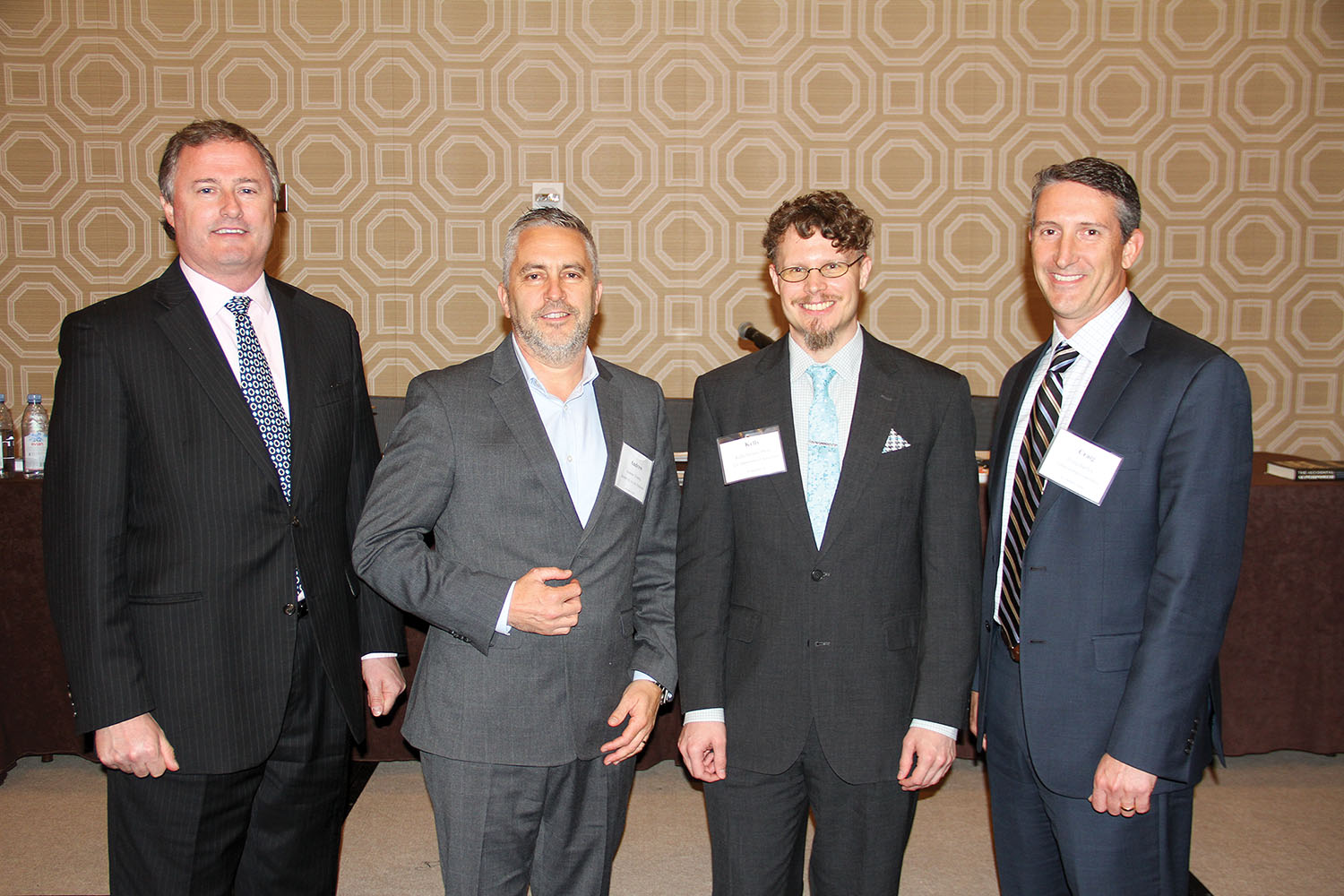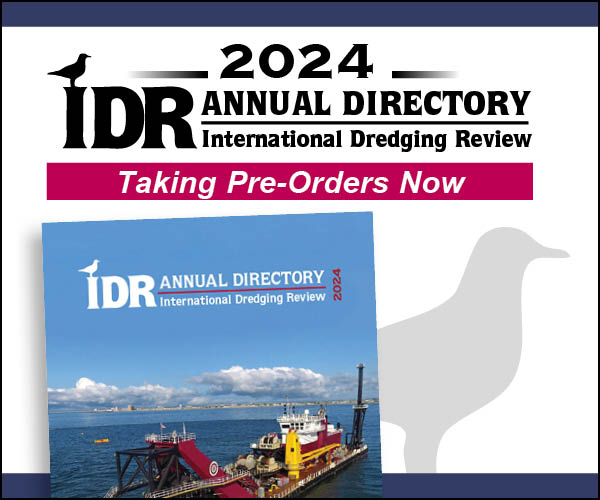The 16th Annual Waterways Symposium, held in Pittsburgh, Pa. November 7–8, once again offered a packed schedule of substantive, thought-provoking presentations on topics of interest to the inland waterways industry.
An impressive lineup of speakers explored the global economic outlook and its effects on the waterways industry, along with the many ramifications of the revolution in U.S. energy supplies due to hydraulic fracturing. The event, sponsored by Waterways Council Inc., Informa Economics IEG and The Waterways Journal, was held at the Fairmont Hotel in downtown Pittsburgh.
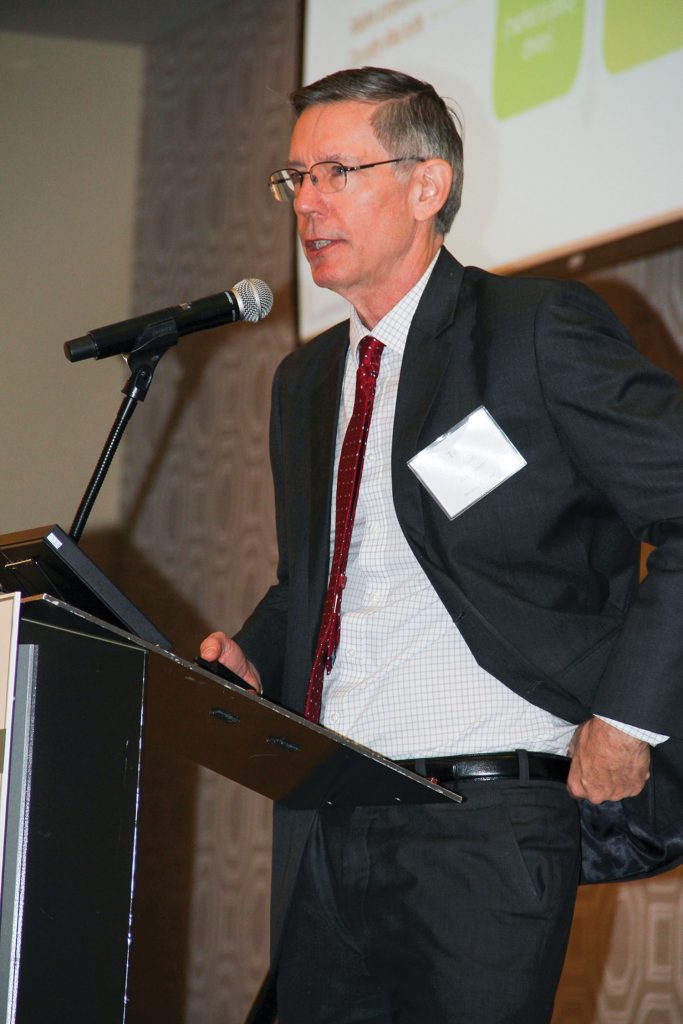
Macroeonomic Outlook
The U.S. economy is not yet in recession, nor is a recession imminent, but the economy is nevertheless vulnerable to any one of a number of possible risks on the horizon. That was the view of Tom Scott, global director of agribusiness consulting for IEG Vantage, who gave an overview of macroeconomic trends and risks. After he was introduced by Peter Stephaich, chairman and CEO of Campbell Transportation and current chairman of the board of the Waterways Council Inc., Scott moved rapidly through a series of charts and statistics illustrating the world economic scene.
He said commodity prices remain “restrained” with soft global demand. In the near term, he said, U.S. monetary policy will remain “accommodative,” but already-low interest rates have left little scope for policy stimulus in the next recession. The ongoing strength of the U.S. economy, currently the world’s strongest, means the dollar should appreciate moderately in the near term at it continues to attract foreign investment.
Among the risks that could change that scenario are continued U.S./China trade tensions, trade conflicts among other players, conflicts in the Middle East and a hard Brexit. The unwinding of global trade agreements requires a global “resetting’” of trade relations, and this has caused what Scott said was a level of social protests around the world unmatched since the late 1960s or early 1970s. He cited popular protests in Hong Kong, Chile, France, Spain, Brazil, Ecuador, Iraq and Lebanon. Widespread social unrest in Chile led Chile’s president to cancel an international trade meeting to be hosted there at which Donald Trump and Chinese President Xi Jinping were expected to announced a new trade agreement.
None of these ongoing protests are targeted at America, said Scott. Instead, they all have different local causes: a pension and corruption crisis in Brazil, the return of Peronism in Argentina; Iran’s influence and the demotion of a popular general in Iraq; secessionism in Catalonia; and a proposed tax on the Internet app WhatsApp in Lebanon.
However diverse their immediate causes, the protests all reflect an increasing level of dissatisfaction of voting populations around the world with politicians, said Scott.
World Trade Decelerating
The European economies performed beyond expectations in 2017, said Scott, but the trade and tariff wars have hit them hard—especially Germany, whose economy is heavily export-dependent. World trade has decelerated as protectionism has grown.
While Scott doesn’t necessarily see a world recession as imminent either, he does foresee a slowing of world trade to the 2–3 percent annual growth range, instead of the 4–5 percent annual growth it had enjoyed for years. The cyclical forces acting on world trade include a maturing global expansion, a slowdown in capital spending and weak commodity prices. Structural factors include trade protectionism, a shortening of supply chains and advances in technology.
Scott said the U.S. economy is performing better than the global economy right now, driven mostly by consumer spending. Despite virtual full employment (unemployment is expected to reach 3.3 percent by 2021), inflation has been moderated—which is good news for workers and their spending, but is a constraint on capital expansion. Scott said he foresees a gradual slowing in the U.S. to a 2 percent annual growth range. Although the twin U.S. deficits have mostly been absent from larger conversations about the economy, Scott said they were manageable—but only assuming growth rates of at least 2 percent.
On the energy front, the U.S. recently exported more energy than it imported for the first time since the 1970s. Despite the oil fields of Venezuela being taken largely offline—along with much of Iran’s production due to sanctions—and the drone attack on one of Saudi Arabia’s largest refineries, the U.S. has been able to stabilize the world energy markets. The failure of global oil prices to rise after these events shows the extent to which the U.S. can now control global oil markets, he said.
The ongoing effects of the tariffs between the U.S. and China could shave .6 percent off U.S. gross domestic product (GDP). Whatever agreements are reached before the 2020 election won’t deal with the real issues dividing the two countries, which will be “kicked down the road,” he said. The trade war was ratcheted up in stages, and any fix will also be in stages, he said.
Scott said the future growth engine of the world economy lies not in China—which is carrying a corporate debt load of 150 percent of GDP, as opposed to the U.S.’s 75 percent—but in the rest of Southeast Asia. Indonesia can anticipate a 5 percent growth rate, he said, fueled by heavy investments in fixed infrastructure. Outsourcing of information technology will continue in Malaysia and the Philippines, contributing to their growth.
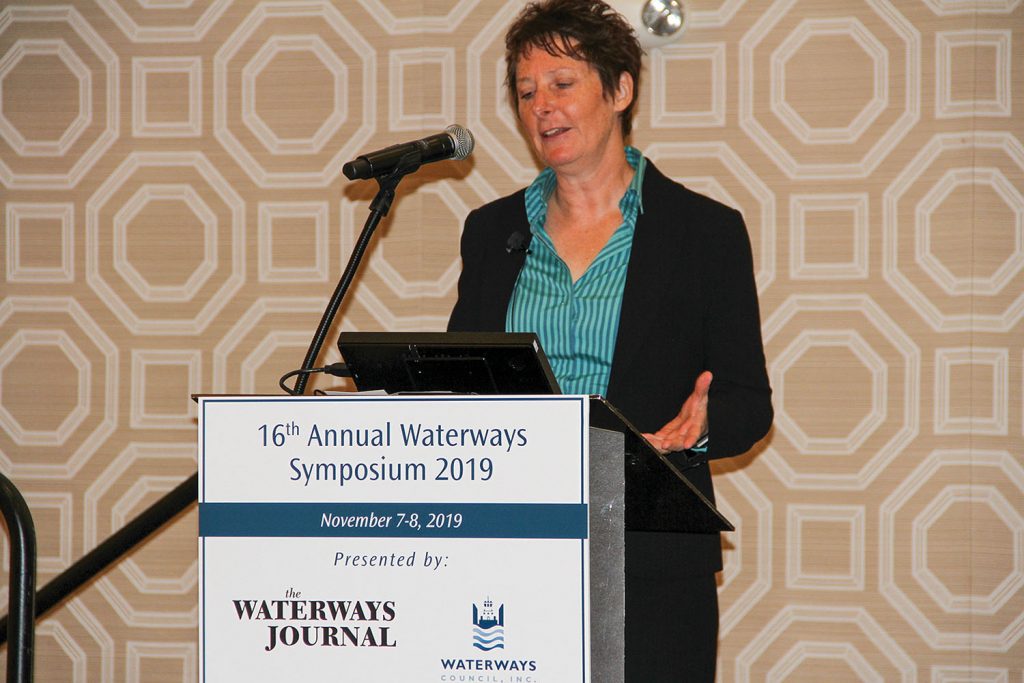
Shell Ethane Cracker Update
Hilary Mercer, vice president of Pennsylvania Chemicals, a division of Shell Chemicals, gave a presentation on the ethane cracker being constructed in Monaca in Beaver County, Pa. A transplanted Brit with a degree in engineering from Oxford University, Mercer is the lead executive on the project and has supervised gas projects all over the world for Shell.
The Shell plant is the largest engineering project in the country, one of the largest being overseen by global engineering firm Bechtel, and the largest in the region since World War II. It has contributed to a renaissance in the kinds of manufacturing jobs Pittsburgh was known for before it had to reinvent itself after the steel industry shrank. The plant has several components to allow it to crack ethane gas to create ethylene, then allow the ethylene to aggregate to become polyethylene pellets. These are the building blocks of many kinds of plastics in many manufacturing applications, from food films to plastic parts in automobiles.
The Monaca site, which also generates its own power with a 250 megawatt power station, is the only ethane cracker outside the Gulf Coast. The key to its profitability, said Mercer, is its location close to the region’s Marcellus Shale, source of its natural gas feedstock, and within 700 miles of 70 percent of its customers, manufacturers who convert the pellets to various products.
The site formerly housed a zinc smelter and had to be remediated and prepared, including filled with clean fill to depth of 14 feet. Because the area is hilly, said Mercer, it was crucial that the plant be located on a river, so that heavy equipment could be safely and economically moved by water. “Sixty percent of everything the plant needs moves by water,” said Mercer; the site has its own roll-on/roll-off jetty for heavy equipment. Without water transport for the plant’s compressors, for example, they would have had to be moved by road, requiring the raising of all toll bridges on the Pennsylvania Turnpike.
In November 2018, a 300-foot-tall quench tower was installed. It took 12 hours to lift it into position by the world’s fifth-largest crane in one lift. These towers are usually installed in two sections that are welded together, but because it was able to be moved by barge up the Mississippi and Ohio rivers, it was moved from South Korea (where it was built) and installed in one single piece.
Another piece of equipment called a slurry reactor was lifted into place by the world’s second-largest crane, which Mercer called MOAC—“the mother of all cranes.” It was on-site for a year, and came packed in parts in containers which then formed its own counterweight.
In April, the concrete roof was poured for an ethylene tank, being lifted into place from the inside by air pressure. Gas phase reactor purge bins were also installed in April. According to Mercer, most of the heavy equipment is in place, with five more barge loads expected. “The rest of the year will be all about connecting pieces,” she said.
Mercer pointed out that plastic from polyethylene is essential for much of the “green transition.” About 60 percent of a Tesla electric car is plastic, for example, contributing to its lighter weight and reduced carbon footprint. Plastics are also essential to such green technologies as solar cell panels and batteries. Shell has invested between $1 and $2 billion in alternative energy, she said, and is one of the founding members of the Alliance to End Plastic Waste.
Mercer concluded with a video prepared by Bechtel on the plant.
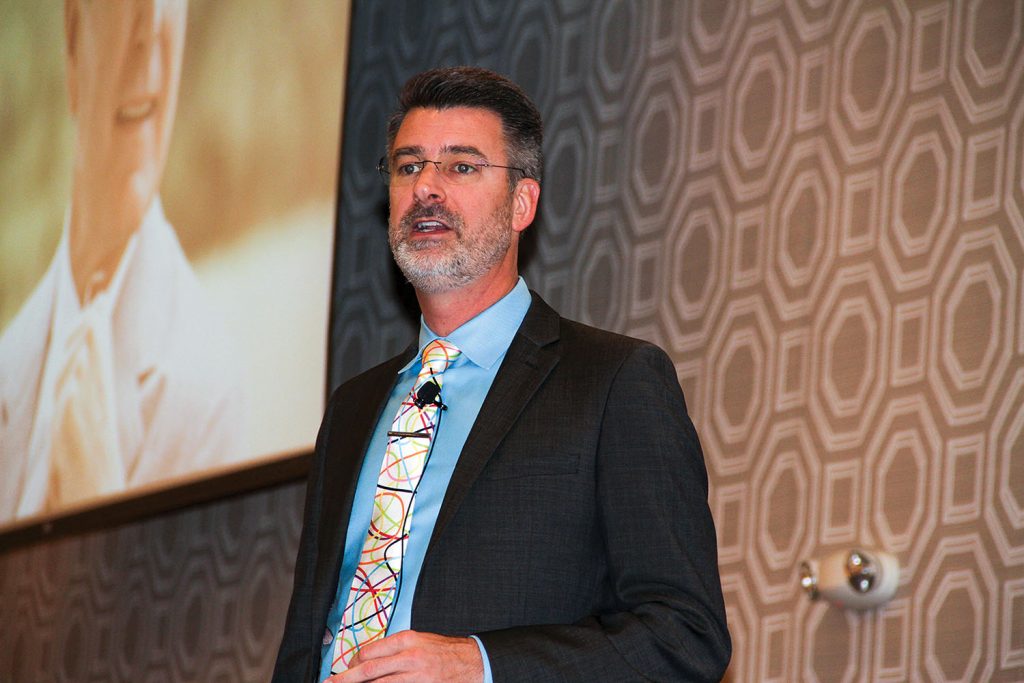
Geopolitical Keynote
The keynote speaker was Peter Zeihan, a geopolitical consultant known for several best-selling books including 2014’s “The Accidental Superpower,” in which he argued that America’s river network was largely responsible for its becoming a superpower. He followed up with “The Absent Superpower,” about America’s current withdrawal from the global security and trade system it set up after World War II, and has another book due this spring.
The U.S. is the least export-dependent of the major economies, Zeihan said. During the Cold War, the U.S. tolerated various unfriendly trade practices from some of its partners and allies in the name of Cold War solidarity, but no longer has to do so. As an example, Zeehan said that the first version of the North American Free Trade Agreement (NAFTA) contained 70 exemptions and exceptions for Canada; not one of these is included in NAFTA II. Japan has recently signed trade agreements with the U.S. that go deeper than any signed during the Cold War, he said.
Zeihan predicted that there would be no serious trade agreement between the U.S. and China until after the 2020 elections, and that the “hard Brexit,” or Britain’s exit from the European Union without an exit agreement in place, would result in the financial hub of the world moving from London to New York.
The output from U.S. shale fields, both oil and gas, is reshaping international energy markets. Zeihan said U.S. shale oil will be cost-competitive with Saudi Arabian crude by the end of the year. He pointed out that the natural gas output is outpacing our ability to handle and store it; about half of all U.S. natural gas is sold at a loss or flared. “The entire petrochemical section is relocating to the U.S.,” he said.
What’s Moving On The Waterways
Following Zeihan, Ken Eriksen, senior vice president at IEG Vantage, led a commodities panel. His fellow panelists included Kelly Nelson, an economist at USDA-AMS covering transportation and marketing services; Andrew Young, a functional logistics manager for Bechtel Oil, Gas & Chemicals; and Craig Darilek, senior manager of chartering for Valero Energy Corporation.
Eriksen began with a review of the latest barge fleet statistics and this year’s “epic” barge season. Because of late plantings, the harvest is still underway, especially of soybeans. Even without this year’s tariff wars, flooding and other weather events, said Eriksen, China’s swine fever epidemic would have led to a great unravelling of grain trade.
This year’s flooding also “torpedoed” the coal export program. “Coal has yet to find its bottom,” said Eriksen.
The barge fleet grew slightly in 2018, and Eriksen sees a shrinkage in 2019 because there are too many open barges. About 2,800 barges dating from the 1990s are waiting to be removed.
The covered barge fleet remains young, while jumbo hoppers are slightly more aged. The tank barge fleet seems adequate overall, but varies by type. There is no need to add to the tank barge fleet, although replacement is OK, he said.
There was a strong price for scrap metal in 2012; a price fall-off since then doesn’t encourage scrapping.
Average distances of grain barge movements are “perking back up,” he said, but from a low base. Corn exports have been “horrid,” totaling about 1.86 billion bushels, down about 1 billion bushels, but are expected to ramp up next year. Within the next five years, the U.S. could be exporting up to 3 billion bushels of corn a year (the record in one year is 2.7 billion bushels). South America has planted 70 percent of this season’s soybeans, with no serious weather problems so far.
Nelson, focusing on grain barge transportation, noted that total volumes in 2019 fell way below the three-year average. Besides weather and flooding, regular lock maintenance and outages also affected that figure. Nelson’s presentation relied on the report that IEG Vantage prepared for the USDA’s Agricultural Marketing Service and released in August, “The Importance of Inland Waterways to U.S. Agriculture” (WJ, September 2). The report sketched out three funding scenarios for inland waterways infrastructure: continuing with the status quo on inadequate funding; increased investment; and decreased investment. Increased investment would increase the “draw area” for river ports to about 270 miles, and $6 billion more in waterways infrastructure investments would lead to a $72 billion impact on GDP.
Darilek gave an overview of petroleum, noting that refinery utilization currently stands at 93 percent. There is rising demand around the world for fuels, especially diesel. The upcoming switch to low-sulfur marine fuels mandated to take place by 2020 by the International Maritime Organization is also driving refinery activity.
U.S. petroleum exports quadrupled during the last decade, most to Mexico and Latin America. The 2015 lifting of an export ban dating from the 1970s boosted exports. Darilek noted that eight of 15 Valero refineries are located on the inland waterways and facilitate 9,800 barge transfers per year totaling 15.5 million tons. About three-quarters of that is blend stocks for refineries; and a quarter is finished products. Crude, diesel, gasoline and residual products are the most common petroleum products moved. In 2014, about 15,000 barrels per day of ethanol were moving downriver; by 2018, that figure had increased to 25,000 barrels per day.
For those moving petroleum products on the waterways, said Darilek, the main issue is not delays caused by necessary maintenance, but reliability and predictability. “Bullish” factors affecting petroleum transportation include increased production, continued demand growth, and the upcoming IMO 2020 fuel switch. “Bearish” factors include the difficulties of logistics optimization and the lag in pipeline construction due to opposition by activists and politicians, especially in the northeast, where many energy customers live.
Mega-Projects
Young then spoke on “Mega-Projects on the Inland Waterways,” covering some of the same ground as Mercer’s presentation on the Beaver County Shell ethane cracker.
Young said the “typical” petrochemical project involved 195 modules; 25 heavy lifts; 55,000 feet of structural steel; 4,500 construction workers; and 4.3 million tons of cargo.
When Bechtel develops an engineering project, it is interested in “de-risking” it as much as possible, said Young. He put up information from a Corps of Engineers website showing that Montgomery Lock on the Ohio River has a 50 percent chance of its middle wall failing by 2028; he said that’s an example of significant risk in considering project logistics since failure would shut down the Upper Ohio River. Bechtel sent a team of engineers to Montgomery to conduct its own risk assessment.
A Corps engineer in the audience said the Corps is addressing the middle-wall issue and repairing the crack, and that failure risk at Montgomery would be greatly reduced for the next 20 years.
Shale’s Contribution To Economy
Next up was David Spigelmyer, president of the Marcellus Shale Coalition, the nation’s largest shale development trade association, based in Pittsburgh. The Marcellus Shale play is the second-largest producer of natural gas in the U.S., producing about 18 billion cubic feet per day from 9,340 producing wells (out of 11,208 total wells in the play).
Spigelmyer said it’s not fracking per se that has produced the boom, since wells have been fracked since the 1940s; it’s the drillers’ increasing sophistication and skill in horizontal drilling, learning how to send a drill bit in many different directions. Drillers have learned to greatly reduce their footprint; they are now able to fit 12 to 14 wells on a single drilling pad.
Since the Marcellus boom began, production has shifted from the state’s northeast to its southwest. Between 2008 and 2017, the state went from being a net energy importer to a net exporter. The average price of natural gas on the NYMEX is about $2.43 per cubic foot, as opposed about $1.32 for Pennsylvania gas. Wholesale electricity prices in the state have plunged by 41 percent since 2008, and natural gas prices for end-users are down by 56 percent since then, making the state much more attractive to businesses.
But because of opposition from politicians and activists in the nation’s northeast, the U.S. lacks the pipeline infrastructure to get that gas to the regions with the highest energy prices. As a result, according to the Global Energy Institute, residents of Massachusetts and Connecticut pay the highest energy prices in the U.S.
Regarding the environment, Spigelmyer said there have been 19,000 inspections of “unconventional” (fracked and horizontally drilled) wells “and we asked for that.” The state’s air quality has dramatically improved, with an 11 percent drop in greenhouse gases between 1995 and 2015 and a drop in volatile organic compounds as well. Fourteen natural gas power plants have been built from the ground up, and six more have been retrofitted from coal to natural gas. “One in every three electrons produced in Pennsylvania today comes from natural gas,” he said. There is room for four or five additional ethane facilities in Ohio, he said.
About 70 percent of U.S. oil and 75 percent of natural gas is produced by hydraulic fracturing today. A study by management consultant McKinsey & Company found that shale energy contributed 100,000 new jobs and $60 billion to GDP. If fracking was banned, the study predicted that 14. 8 million jobs would be lost and gasoline prices would increase by 53 percent. Natural gas prices would go up by 400 percent. The total cost of a fracking ban would amount to about $4,000 per household in out-of-pocket expenses by 2022.
In the question period, one questioner asked Spigelmyer about the barging of brines used in fracking. Early brines were treated and released into the waterways, but a 2011 regulation stopped that practice. Brines were becoming more concentrated as the drilling has become deeper, so today’s production water is recycled. There are many possible uses for it, said Spigelmyer, and it could absolutely be shipped on the waterways, he said.
Built To Last
To finish the first day’s presentation, Wade Beasley, business representative, of Carpenters Local 174, Chicago Regional Council of Carpenters, and Paul Rohde, vice president-Midwest of Waterways Council Inc., introduced “Built to Last,” an episode of an Emmy-nominated season of documentaries chronicling the contributions of the nation’s skilled workforce. This one focused on the contributions of skilled union labor to lock and dam projects.
Capital Investment
The second day’s panel discussion focused on capital development strategies for the nation’s lock and dam and waterway projects. Mike Monahan, vice chairman of the Inland Waterways Users Board, moderated the discussion. He said WCI members have had “numerous’ meetings with members of Congress this year on the inland waterways capital development strategy. This is the year when the Water Resources Reform and Development Act of 2014 has to be updated and “refreshed.”
Monahan said the industry’s No. 1 priority is making sure all trust fund monies are spent efficiently. The second priority is full funding of the Navigation and Ecosystem Project (NESP). The third is conforming the cost–share for funding of lock and dam projects from a 50/50 cost share with the federal government to a permanent 75/25 cost share. The same was done in the deep-draft navigation program in Water Resources Development Act of 2016. Another goal, said Monaghan, is getting the Corps of Engineers to include more factors in the way it assesses the costs and benefits of waterways infrastructure. There is no way, for example, for the Corps to factor in the many benefits of the Monaca ethane cracker plant to the economy, yet speaker after speaker testified that the Ohio River and its lock and dam system were key factors in the decision to locate there.
Tom Heinold, chief of operations for the Rock Island Engineer District, reported that the gates at Upper Mississippi River Lock 13 were recently replaced; they were the original gates, dating back to the 1930s. Throughout the lock and dam system, he said, half of all towboats experience some delay at locks.
By 2023, he said, all miter gates in his district will have been replaced and will be 25 years old or younger. Heinold noted that although NESP was authorized by Congress in 2007, there has been not a dime of funding since. If NESP was fully funded, with its seven brand-new 1,200-foot lock chambers, it would reduce lockage times by 50 percent.
Heinold said the Corp’s official numbers in assessing the benefits of lock and dam projects do not fully account for all their benefits. Despite that, those benefits are so well recognized by the state of Iowa that it wants to give the Rock Island District $2 million toward the cost of building mooring cells downstream of Lock and Dam 14.
Heinold, like Young, also referred to the recently released report on waterways prepared for the U.S. Department of Agriculture, which calculates benefits of waterways differently from the Corps, and joked, “I want to hire Department of Agriculture economists.” He said the benefit-cost ratio numbers, as the Corps calculates them, anticipated to be in the 1.2 range-that is, 1.2 dollars of benefit for every dollar of cost. The estimates assume either static traffic or a slight increase over the next 50 years, so “we can account only for the improved speed and reliability of the system.”
Illinois River Closures
Next year, beginning July 1, all six locks on the Illinois Waterway will be closed for scheduled maintenance and major repairs, because the barge industry had persuaded Congress and the Corps to consolidate all the closures. Heinold said although the system is supposed to reopen September 30, an October 30 opening is more likely.
Heinold said his district was able to get all the preparatory work at Marseilles and Starved Rock locks and dams done this year, despite some delays due to flooding and weather events. Those events led to a slight dip in traffic on the Illinois Waterways system, he said, but it’s up to the barge industry and its advocates to explain to Congress that this was not a normal year and the reasons for continuing to invest in the system remain sound.
The planned Illinois Waterway closures are all funded. However, work on Brandon Road Lock and Dam depends on FY2020 funding still to be passed. If Congress resorts to continuing resolutions to fund government because it can’t agree on funding bills, said Heinold, or because it is distracted by impeachment or other matters, necessary funding for lock and dam projects could be hurt.
Upper Ohio Work
Col. Andrew “Coby” Short, commander of the Pittsburgh Engineer District, gave an overview of the district, which has 328 miles of navigable waterways and did $320 million worth of business last year. It includes 16 reservoirs and has 700 employees. Short reported on the Upper Ohio Navigation Study, which recommends for Congressional authorization the National Economic Development (NED) plan for improving the Upper Ohio River navigation system, specifically the Emsworth, Dashields and Montgomery Locks and Dams. Emsworth, Dashields and Montgomery, each constructed prior to 1936, are the first three locks and dams on the Ohio River just below Pittsburgh’s Point. Because they use wooden pilings, said Short, they must be replaced rather than repaired. The cost estimates for that are about $2.3 billion over a period of 10 years.
GIWW Priorities
Finally, Jim Stark, president of the Gulf Intracoastal Canal Association (GICA), gave an overview of challenges and issues along the Gulf Intracoastal Waterway. In 2018, the Maritime Transportation Research and Education Center found that the GIWW supports 143,000 jobs and has an economic impact of $61.5 billion.
The main challenges have to do with necessary repairs to navigation structures on the GIWW for which there is no alternative route. The Inner Harbor Navigation Canal lock in New Orleans, built in 1923, is completely inadequate for the needs of modern towboat traffic. Its walls are leaking and the wooden forms are deteriorating. The lock’s 1920s machinery was replaced a few years ago. A reroute from the lock would take towboats 11 days out of their way up the Mississippi River to the Ohio River and back down the Tennessee-Tombigbee system. A coastal detour was worked out a few years ago, but it exposes barges to the open seas of the Gulf of Mexico. “It’s dicey, and not a real solution for the future,” said Stark. A Director’s Report has already been authorized, and the cost-benefit ratio is estimated at 1.78.
A replacement study is underway, and the Director’s Report is expected by February 2020. Local residents are wary of any changes and have led numerous lawsuits against the Corps to require more studies. Right now the project is estimated to take 11 years, but it could be speeded up with more funding.
On the Brazos River, a set of floodgates built to keep silt out of the canal are due to be replaced. Among their issues: the gates were designed at a time when barges were mostly towed astern in the area. They require tows to be broken up to pass through, and are closed for some portion of each day all year. Still, about 23 million tons a year of cargo, mostly petroleum and chemicals, pass through.
A Chief’s Report was signed on October 23, calling for the removal of the west gate, the widening of the navigation channel to 12 feet, at an estimated cost of $158 million; the benefit/cost ratio is estimated at 5.0.
On the Colorado River, a similar set of floodgates eventually became locks. This year, it took 40 days to clear the locks from spring flooding and debris. The Corps is still assessing the system-wide benefits of the structures in reduced dredging and other costs.
Question and answer sessions returned to the theme of what happens to these projects if Congress fails to pass a funding bill and relies instead on continuing resolutions to temporarily fund the government.
Caption for top photo: Commodities Panel, from left: Ken Eriksen, Andrew Young, Kelly Nelson and Craig Darilek. (Photo by Nelson Spencer Jr.)


